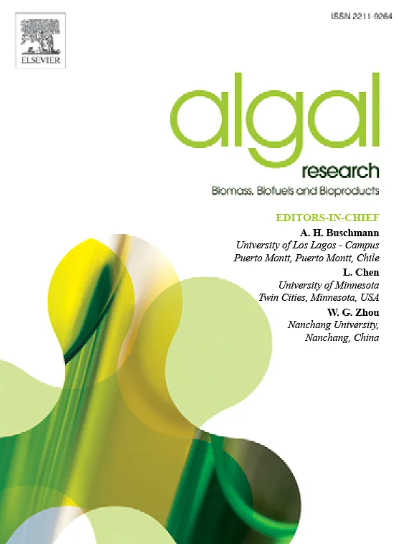外源褪黑素调控的微藻对草甘膦和四环素的生理响应
IF 4.5
2区 生物学
Q1 BIOTECHNOLOGY & APPLIED MICROBIOLOGY
Algal Research-Biomass Biofuels and Bioproducts
Pub Date : 2025-05-08
DOI:10.1016/j.algal.2025.104081
引用次数: 0
摘要
微藻具有良好的环境适应性,在废水生物修复中具有重要的应用前景。本研究系统地评估了草甘膦(除草剂)和四环素(抗生素)对四种微藻的影响,包括小球藻、四角藻、小球藻和毛藻,同时阐明了褪黑素在胁迫恢复中的调节作用。结果表明,800 μg/L的草甘膦能促进所有物种的生长,使四角田鼠的细胞数量增加42.25%。低浓度的草甘膦促进了sorokiniana的生长,而高浓度的草甘膦则抑制了它的生长。四环素(10 μg/L)促进了sorokiniana的生长,50 μg/L时生物量增加25.77%。有机污染物增加丙二醛(MDA)含量,降低过氧化氢酶(CAT)活性。草甘膦对毛藻CAT活性的抑制作用为28.00%。褪黑素(10 μg/L)显著提高了草甘膦胁迫抗性,在10 μg/L草甘膦处理下,柽柳生物量增加49.58%。褪黑素降低了小球藻体内MDA水平(降低18.55% ~ 56.11%),显著提高了CAT活性(增加108.37%)。褪黑素促进了四角藻、小球藻和毛角藻体内脂质积累,其中小球藻脂质含量达到对照的2.58倍。该研究为优化针对草甘膦和四环素污染废水的微藻处理系统提供了重要见解,特别是通过褪黑激素介导的应激缓解策略。本文章由计算机程序翻译,如有差异,请以英文原文为准。

Physiological characteristics of microalgae in response to glyphosate and tetracycline regulated by exogenous melatonin
Microalgae exhibit significant promise in wastewater bioremediation owing to their exceptional environmental adaptability. This investigation systematically evaluated the effects of glyphosate (herbicide) and tetracycline (antibiotic) on four microalgal species Chlorella sorokiniana, Scenedesmus quadricauda, Chlorella sp., and Chaetoceros sp., while elucidating melatonin's regulatory role in stress resilience. The results showed that 800 μg/L glyphosate promoted growth in all species, with the cell counts of S. quadricauda increasing by 42.25 %. Low glyphosate concentrations stimulated C. sorokiniana growth, while high concentrations inhibited it. Tetracycline (10 μg/L) enhanced growth, with C. sorokiniana biomass increasing by 25.77 % at 50 μg/L. Organic pollutants increased malondialdehyde (MDA) content and decreased catalase (CAT) activity. Glyphosate inhibited CAT activity in Chaetoceros sp. by 28.00 %. Melatonin (10 μg/L) significantly improved stress resistance, increasing S. quadricauda biomass by 49.58 % at 10 μg/L glyphosate. Melatonin attenuated MDA levels (18.55 % to 56.11 % reduction) and markedly elevated CAT activity (108.37 % increase) in Chlorella sp. Melatonin promoted lipid accumulation in S. quadricauda, Chlorella sp., and Chaetoceros sp., with the lipid content of Chlorella sp. reaching 2.58 times than the control under combined melatonin-glyphosate treatment. This study provides critical insights for optimizing microalgae-based treatment systems targeting glyphosate- and tetracycline-contaminated wastewater, particularly through melatonin-mediated stress mitigation strategies.
求助全文
通过发布文献求助,成功后即可免费获取论文全文。
去求助
来源期刊

Algal Research-Biomass Biofuels and Bioproducts
BIOTECHNOLOGY & APPLIED MICROBIOLOGY-
CiteScore
9.40
自引率
7.80%
发文量
332
期刊介绍:
Algal Research is an international phycology journal covering all areas of emerging technologies in algae biology, biomass production, cultivation, harvesting, extraction, bioproducts, biorefinery, engineering, and econometrics. Algae is defined to include cyanobacteria, microalgae, and protists and symbionts of interest in biotechnology. The journal publishes original research and reviews for the following scope: algal biology, including but not exclusive to: phylogeny, biodiversity, molecular traits, metabolic regulation, and genetic engineering, algal cultivation, e.g. phototrophic systems, heterotrophic systems, and mixotrophic systems, algal harvesting and extraction systems, biotechnology to convert algal biomass and components into biofuels and bioproducts, e.g., nutraceuticals, pharmaceuticals, animal feed, plastics, etc. algal products and their economic assessment
 求助内容:
求助内容: 应助结果提醒方式:
应助结果提醒方式:


